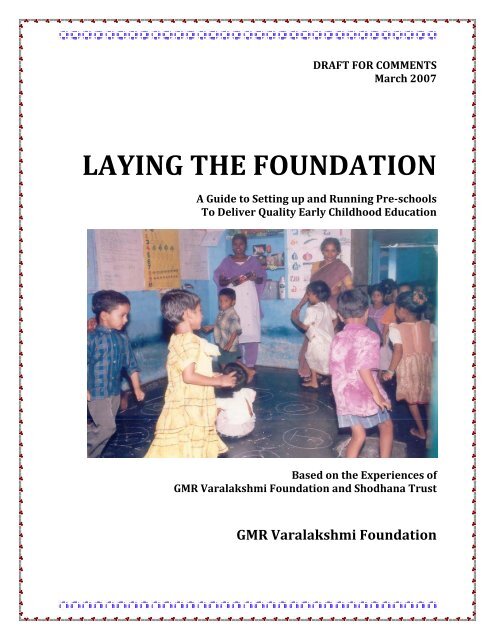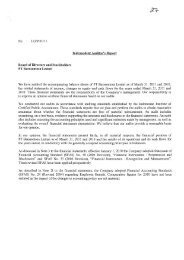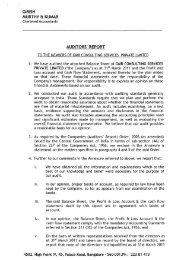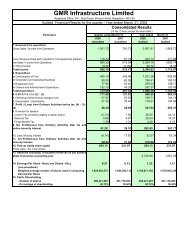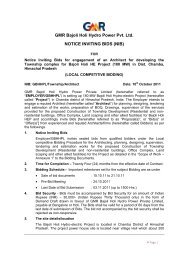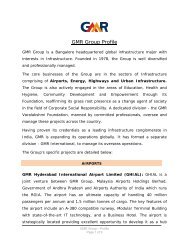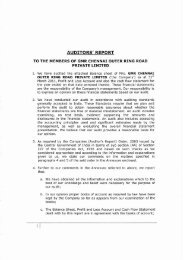LAYING THE FOUNDATION - GMR
LAYING THE FOUNDATION - GMR
LAYING THE FOUNDATION - GMR
Create successful ePaper yourself
Turn your PDF publications into a flip-book with our unique Google optimized e-Paper software.
DRAFT FOR COMMENTS<br />
March 2007<br />
<strong>LAYING</strong> <strong>THE</strong> <strong>FOUNDATION</strong><br />
A Guide to Setting up and Running Preschools<br />
To Deliver Quality Early Childhood Education<br />
Based on the Experiences of<br />
<strong>GMR</strong> Varalakshmi Foundation and Shodhana Trust<br />
<strong>GMR</strong> Varalakshmi Foundation
EARLY CHILDHOOD EDUCATION<br />
Comments<br />
The following excert from the Draft National Curriculum<br />
Framework (2006), provides the context and framework<br />
for the <strong>GMR</strong> Varalakshmi Foundation in the area of preschool<br />
education.<br />
“The early childhood stage, until the age of 6-8<br />
years, is the most critical period when the foundations<br />
are laid for life-long development and<br />
the realization of full potential; research shows<br />
that there are ‘critical periods’ at this stage for<br />
full development of the brain’s potential. The<br />
formation of later attitudes and values as well as<br />
the desire to learn are also influenced at this<br />
stage, while lack of support or neglect can lead<br />
to negative consequences, sometimes irreversible.<br />
Early Childhood care and Education<br />
(ECCE) requires that young children be provided<br />
care, opportunities and experiences that lead to<br />
their all-round development — Physical, mental,<br />
social and emotional, and school readiness. A<br />
holistic and integrated perspective views the<br />
health and nutritional needs of children as integrally<br />
related with their psychosocial/educational<br />
development. The curriculum framework and<br />
pedagogy for ECCE must be based on this<br />
holistic perspective, taking into account the<br />
various domains of development, the characteristics<br />
of children at each sub-stage, and their<br />
learning needs in terms of experiences.<br />
It is well known that children have a natural<br />
desire to learn and make sense of the world<br />
around them. Learning in the early years must<br />
hence be directed by the child’s interests and<br />
priorities, and should be contextualized by her<br />
experiences rather than being structured formally.<br />
An enabling environment for children<br />
would be one that is rich in stimulation and<br />
experiences, that allows children to explore,<br />
experiment and freely express themselves, and<br />
one that is embedded in social relations that<br />
give them a sense of warmth, security and trust.<br />
Playing, music, rhyming, art and other activities<br />
1<br />
Laying the Foundation
Comments<br />
using local materials, along with opportunities for<br />
speaking, listening and expressing themselves,<br />
and informal interaction are essential components<br />
of learning at this stage. It is important that<br />
the language used in early education is one that<br />
the child is familiar with in the immediate environment,<br />
while an informal multilingual classroom<br />
would help children to comfortably adjust<br />
to the early introduction of a second language<br />
(English) and the medium of instruction from<br />
class I onwards. As the children who come<br />
under the purview of ECCE are a heterogeneous<br />
group, ranging from infants to pre-schoolers, it is<br />
important that activities and experiences for<br />
them are developmentally appropriate.<br />
Early identification of disabilities assessment<br />
and the provision of appropriate stimulation<br />
would go a long way in preventing the aggravation<br />
of disadvantage on this account. The caution<br />
would be against pressurizing children into<br />
the three R’s (reading, writing and arithmetic)<br />
and the early introduction of formal instruction,<br />
i.e. against making pre-schools into training<br />
centres for admission to primary schools. The<br />
holistic perspective of ECCE and its methodologies<br />
(all-round and integrated development,<br />
activity-based learning, listening and speaking a<br />
language before learning to write it, contextuality<br />
and continuity between home and school) must<br />
inform learning experiences of children throughout<br />
the childhood stage and lead to a smooth<br />
transition into the elementary school stage.”<br />
Draft for comments<br />
2
GOALS OF BALA BADI<br />
Comments<br />
1 To contribute to the healthy physical, mental,<br />
emotional and personal development of the<br />
children.<br />
2. To help children develop into caring, creative,<br />
thinking people, concerned about others and the<br />
world around them.<br />
3. To help children develop a positive self image.<br />
4. To help children develop as confident,<br />
independent and secure individuals.<br />
5. To prepare the children to enter school, ready to<br />
succeed.<br />
6. To guide the child to develop good personal habits.<br />
7. To provide medical attention and nutritional<br />
supplements to help the proper development of<br />
the child.<br />
NUMBER OF CHILDREN<br />
Each Bala Badi shall have 20 – 25 children. At<br />
any rate the number shall not exceed 25.<br />
AGE OF CHILDREN<br />
Children shall be admitted to the Bala Badi after<br />
completion of 3 years. They may remain there<br />
till they are admitted to school (usually upto age<br />
of 5 years).<br />
ADMISSION<br />
Volunteers will conduct a survey of children in<br />
the age group 3 – 5 years in the community.<br />
Parents of children in this age group who are not<br />
attending Anganwadi will be motivated to admit<br />
their children to Bala Badis.<br />
Preference will be given by the Bala Badis to the<br />
most disadvantaged children i.e., the poorest of<br />
3<br />
Laying the Foundation
Comments<br />
the poor, socially disadvantaged children, children<br />
with only one parent, etc.,<br />
ADMISSION TIME<br />
Children will normally be admitted in June / July<br />
of the year, at the start of the term. If there are<br />
vacancies, children may be admitted during the<br />
year, as and when they complete 3 years of age.<br />
ADMISSION PROCEDURE<br />
Volunteers must sit with the parents and fill out<br />
the Form (See Appendix 1 ) and keep the same<br />
on file. Apart from this, the MOU below will also<br />
be signed. Volunteers will discuss the MOU<br />
with the parents. After the discussions, the<br />
parents and volunteer will sign the same.<br />
Draft for comments<br />
4
FOR OUR CHILD’S FUTURE<br />
Comments<br />
We as parents are interested in the healthy overall<br />
development of our daughter / son.<br />
We therefore would like her / him to attend the <strong>GMR</strong><br />
Varalakshmi Foundation Bala Badi.<br />
We understand that through regularly attending the<br />
Bala Badi, our child will learn the basics, and a<br />
strong foundation will be laid for her / his education.<br />
We will support the efforts of the Bala Badis by<br />
1. Bringing the child regularly on time to the Bala Badi<br />
2. Ensuring that he / she comes to the Bala Badi<br />
neat and clean.<br />
3. Taking interest in what the child learns in the<br />
Bala Badi.<br />
4. Ensuring that the child practices the good habits<br />
he / she learns at the Bala Badi.<br />
5. Ensuring that the child is not exposed to bad<br />
language / violence etc., in the home or neighborhood.<br />
6. Ensuring that every child goes to school after<br />
completion of Bala Badi, and continues education<br />
to the level that she / he desires.<br />
7. Attending PTA meetings and giving feedback<br />
and suggestions.<br />
8. Not sending the child to Bala Badi if she / he is<br />
sick.<br />
9. Ensuring that the child has a proper meal before<br />
coming to the Bala Badi.<br />
MO<strong>THE</strong>R FA<strong>THE</strong>R VOLUNTEER<br />
5<br />
Laying the Foundation
Comments<br />
SELECTION OF INSTRUCTOR<br />
Where possible, the instructor must be from the<br />
concern village or community. However, if no<br />
one comes forward, no one is found suitable, or<br />
the issue is too political, instructor may be selected<br />
from a larger area.<br />
The opening for instructor will be publicized so<br />
that all potential candidates are aware. Applications<br />
will be invited from candidates with minimum<br />
standard 10 th pass.<br />
All eligible candidates will be given<br />
a) Written test which checks basic knowledge of<br />
language, grammar and spellings<br />
(English+Telugu); basic mathematics, basic<br />
science and general awareness.<br />
b) Those getting above 60% (or the top 5-6<br />
candidates) will appear for a personal interview<br />
where ability to create a good healthy learning<br />
work with children and give them care; ability to<br />
get on with parents and community; innovative<br />
and enquiring mind; skills in dance, music, arts,<br />
attention to detail; sense of maturity,<br />
responsibility; discipline and integrity will be the<br />
major criteria.<br />
The interview will be conducted of internal persons<br />
along with external experts who share the<br />
approach to ECE.<br />
Remuneration<br />
Volunteers if 10 th pass will be paid Rs.800 and<br />
Rs.900 if 12 th pass in the village situation. However<br />
this will depend on location and local conditions.<br />
HELPER<br />
The helper will be selected from the concerned<br />
community and will preferably be a widow or<br />
Draft for comments<br />
6
lady who has no other means of support. While<br />
there is no minimum educational qualifications,<br />
standard 7 is desirable.<br />
Comments<br />
Selection will be through interview involving<br />
internal and external persons.<br />
The criteria will be to work with and get on with<br />
children; to get on with parents and community;<br />
attention to hygiene and cleanliness; discipline;<br />
integrity; skills and interest in arts and craft.<br />
Remuneration for Helper<br />
Helper will be paid Rs.500/- per month (to be<br />
locally adjusted).<br />
PRESSURES IN SELECTION<br />
The candidate who is best suited for the role<br />
should be selected. While all suggestions are<br />
welcome with regard to potential candidates, the<br />
performance in the selection procedures will be<br />
the only criteria for appointment.<br />
If undue pressures are brought for selection of a<br />
candidate and it is not possible to resolve this<br />
even with community discussions, it is preferable<br />
to withdraw the BB from that village/slum.<br />
TIMING OF SELECTION<br />
Preferably instructor will be selected in April-May,<br />
so that they may undergo training and orientation<br />
and be ready to start by late June.<br />
TRAINING OF BBIS<br />
A five day training programme is essential before<br />
a BBI takes up duties. The training will include<br />
sharing the vision; sharing basics about child<br />
psychology and working with children and the<br />
contents of this manual. Also, skills of working<br />
with children and community. Most important will<br />
be bringing the attitude to ba a successful BBI.<br />
7<br />
Laying the Foundation
Comments<br />
The training will involve 3 days of classroom<br />
sessions (lectures; group and individual activities;<br />
hands-on; experience sharing etc.) and two<br />
days of observation classes at Sodhana.<br />
Every seminar, 3 day refresher programmes will<br />
be organized. In addition one or two exposure<br />
visits / participation in external workshops etc.<br />
will be facilitated.<br />
(Please see Annexure for sample training schedule)<br />
TRAINING OF HELPERS<br />
There will be a two day training for Helpers<br />
which will shars the vision; basics of working<br />
with children and communities; their role and<br />
duties; hygiene and sanitation; and most important<br />
the right attitude.<br />
There will be one-day refresher trainings every<br />
year.<br />
BBI DUTIES AND RESPONSIBILITIES<br />
a) To prepare list of all children in the age group of<br />
3-5 years in the community who are not enrolled<br />
in Anganwadi<br />
b) To admit children of 3-5 years in BB<br />
c) Identify children in the age group of 6-12 years<br />
and get them enrolled into Govt schools<br />
d) To form Mothers’ committee of B B including<br />
with an elected Chairperson to work with them<br />
towards better education in the community, with<br />
special stress on girl’s education.<br />
e) To ensure the smooth and effective functioning<br />
of the B.B as per this manual<br />
f) To work in identifying the creativity and innate<br />
abilities of the children and nurture them<br />
g) To prepare and innovate no cost/low cost TLM<br />
h) To attend the two review meetings held by the<br />
Foundation every month, without fail<br />
i) To attend training programmes conducted by the<br />
Foundation periodically<br />
j) To maintain all records<br />
Draft for comments<br />
8
k) To maintain good relations with his/her<br />
Supervisors and other staff of the Foundation and<br />
be answerable and accountable<br />
l) To use every available opportunity to improve her<br />
communication skills<br />
m)To conduct PTA meetings periodically<br />
n) To be aware of each student intimately and<br />
maintain good relations with the parents<br />
o) To be punctual to the work and be ready at the<br />
BB at least 15 min in advance of the timings of<br />
the BB<br />
p) To have good relations with the ANM and other<br />
local health staff and to educate all mothers’<br />
committee members about the immunization<br />
details of their children and to follow up with them<br />
periodically.<br />
q) To visit every child’s house at least twice in a<br />
year.<br />
r) The BBI is entitled to one CL a month. When he/<br />
she has to go on CL the concerned Supervisor<br />
or the Coordinator must be informed in advance.<br />
Comments<br />
BB HELPER DUTIES AND RESPONSIBILITIES<br />
a) To open the BB centre and clean the room and<br />
premises before the children start coming<br />
b) To go homes of children who have not come to<br />
BB to pick them up and similarly drop them.<br />
However the parents also have an equal<br />
responsibility in this.<br />
c) To keep the children clean and look after their<br />
hygiene and help the BBI in this regard<br />
d) To arrange for safe drinking water facility on the<br />
premises<br />
e) To attend with love and care to the basic needs<br />
of the children of the centre<br />
f) To maintain good relations with the parents and<br />
ensure regular attendance of the children<br />
g) To help the BBI in all her chores<br />
h) To be able to run the centre in absence of the<br />
BBI<br />
i) To prepare and serve the food hygienically and<br />
without loss of nutrition and as per the Menu card<br />
9<br />
Laying the Foundation
Comments<br />
REVIEW MEETINGS OF BBIs<br />
Review meetings will be held once in 15 days.<br />
They will be conducted by concerned supervisor.<br />
Objectives<br />
I. To review the performance of BBs<br />
II. To strengthen the skills and knowledge of the<br />
BBs<br />
III. To announce and discuss programmes to be<br />
taken up in the villages by the Foundation<br />
IV. To create a platform for sharing of knowledge<br />
V. To resolve conflicts if any<br />
VI. To help develop the personality of BBI<br />
VII. To issue snacks and to disburse honorarium<br />
VIII. To help B.Bs solve their problems and learn<br />
from each other<br />
IX. To help disseminate innovate ideas, TCM etc.<br />
X. To be a support mechanism<br />
Scope<br />
To cover all aspects related to Education,<br />
Healthcare, Sanitation and Empowerment<br />
through interactive sessions. General matters<br />
pertaining to running of BBs, cooperation of the<br />
parents and elders, and any other matter related<br />
to BB running will form the scope of the review<br />
meetings.<br />
Requirements<br />
Drawing sheets, sketch pens, water colors,<br />
thermocol sheets etc for the preparation of TLM.<br />
Snacks for the BB children is also disbursed<br />
during review meetings.<br />
Timings<br />
9.30 AM to 4.30 PM.<br />
Draft for comments<br />
10
TRAININGS TO BBIs (Annual Workshop also)<br />
Comments<br />
Objectives<br />
I. To review the systems, procedures, successes<br />
and shortcomings<br />
II. To re-inforce the philosophy and shared inscon<br />
of ECE<br />
III. To help develop the skill set of the BBIs<br />
IV. To introduce new methods of teaching<br />
V. To develop the communication skills of BBIs<br />
VI. To develop the talents of BBIs<br />
VII. To share functions of other NGOs working in<br />
pre-school education<br />
MONITORING OF BBs<br />
Who will monitor and periodicity: The concerned<br />
Supervisor visits a BB at least once a week. (see<br />
Annexures)<br />
What is to be monitored: The following records must<br />
be checked by the Supervisors and Coordinator –<br />
1. Personal diary<br />
2. Student’s profile<br />
3. Achievement record<br />
4. Food material issue book<br />
5. PTA record<br />
6. Talent bank<br />
7. Story telling record<br />
8. Attendance register of students<br />
9. Attendance register of BBI and Helper<br />
In addition to records the performance of the<br />
children is also to be monitored and crosschecked<br />
with Student’s profile.<br />
The maintenance of the BB premises, display of<br />
TLM, Tasting of food material, Personal hygiene<br />
of the children is also to be routinely checked.<br />
The supervisor must observe the BBI conducting<br />
activities and must give feedback.<br />
11<br />
Laying the Foundation
Comments<br />
HOME VISITS<br />
BBI must visit the home of every child atleast<br />
twice a year, in order to build up rapport with the<br />
family and understand the child better.<br />
If there are serious problems in the family, BBI<br />
will bring to supervisor’s notice and efforts need<br />
to be made to find a solution.<br />
DRESSING OF <strong>THE</strong> CHILD<br />
Before the academic term begins, during the<br />
admission, the following will be stressed to the<br />
parents.<br />
1. The child will be bathed and dressed in clean<br />
clothes before being sent to Bala Badis.<br />
2. Child will wear chappals / shoes.<br />
3. A clean piece of cloth / handkerchief will be pinned<br />
to the child’s dress.<br />
4. Child’s nails will be cut once a week.<br />
5. Child’s hair will be oiled, combed before being<br />
sent to Bala Badi.<br />
6. Child will brush his / her teeth.<br />
In case it is found that some children are not<br />
following these, parents will be counseled privately.<br />
No child will be reprimanded publically<br />
for any of these problems.<br />
ILLNESS<br />
In case a child comes to the Bala Badi with<br />
fever, an infectious condition or in any physical<br />
discomfort, the parents will be requested to take<br />
the child back. The parents will be advised to<br />
take the child to the doctor. In case a child falls<br />
ill during the course of the day, the child will be<br />
escorted house at the earliest. In case the<br />
parents are not home, the child may rest at the<br />
Bala Badi till it closes. At the end of the day, the<br />
Instructor will inform the parents of the nature of<br />
the problem.<br />
Draft for comments<br />
12
In case the illness is acute and parents not<br />
available, they will be informed at their work<br />
place.<br />
Comments<br />
INJURIES<br />
In case any child is injured during the course of<br />
the day, appropriate first aid will be given – e.g.,<br />
the wound will be cleaned with water and antiseptic<br />
; antiseptic cream will be applied ; Band<br />
Aid will be applied. Parents will be informed of<br />
how the child got hurt, when they come to collect<br />
the child.<br />
If the child loses consciousness, bleeds through<br />
the nose / mouth / ear, the parents will be immediately<br />
informed. The volunteer shall also immediately<br />
inform his / her supervisor, and accompany<br />
the child and parents to the doctor.<br />
FIRST AID KIT<br />
A properly stocked first aid will be available at<br />
each Bala Badi. (Please see Appendix 2 for<br />
details of contents).<br />
It is the duty of the volunteer to check the availability<br />
and expiry date of the medicines, and<br />
ensure refilling every month.<br />
IMMUNIZATION<br />
The Bala Badi worker will have records of the<br />
immunizations given to each child, and will<br />
remind the parents at appropriate time for getting<br />
the immunizations done. The Bala Badi worker<br />
will also take the children for Pulse Polio immunization<br />
whenever the same takes place.<br />
MEDICAL CHECK-UPS<br />
Medical check up of all B.B children will be done<br />
twice a year. One or both parents should be<br />
present at this time. The format in Appendix –<br />
will be used to keep a record. Children identified<br />
13<br />
Laying the Foundation
Comments<br />
suffering with serious problems will be facilitated<br />
for further care at government hospitals.<br />
In case of ailments needing short term medication,<br />
doctor will prescribe and B.B Instructor will<br />
work with parents to ensure the medication<br />
course is completed.<br />
Doctor may use his/her judgement to give Vit A,<br />
de-worming and iron tablets to all the children.<br />
Doctor and B.B Instructor will counsel the parents<br />
individually and collectively for better health,<br />
based on the results of the medical check up.<br />
PTA MEETINGS<br />
PTA meetings shall be conducted once a month<br />
in the presence of a supervisor. The overall<br />
progress of the class, as well as special highlights<br />
of the past month plus plans for the next<br />
month will be presented. Comments, suggestions<br />
will be sought from parents in an open<br />
positive spirit. The atmosphere will be friendly<br />
and comfortable for the parents.<br />
A written record of all suggestions will be maintained.<br />
Feedback on implementation of previous month’s<br />
suggestions will be given.<br />
After the general meeting, each child’s parents<br />
will be briefed individually on their ward’s progress.<br />
SPACE<br />
Ideally, the Bala Badi should be situated in an<br />
open plot of land, with a building following Plan<br />
A. The dimensions of the plot should be<br />
_________________________<br />
and of the building should be __________<br />
______________________________________________________________________.<br />
There should be a small toilet on the plot, as<br />
shown in the plan.<br />
Draft for comments<br />
14
The bare land around the building should be<br />
smooth, with no stones / wild growth etc., There<br />
should be no puddling of water, nor any open<br />
drains in the plot.<br />
Comments<br />
However, it is recognized that this may not always<br />
be possible. As an alternative while efforts<br />
are on to secure land and building, the Bala<br />
Badis may be run in a house, provided that the<br />
house is spacious enough to accommodate the<br />
children ( at least<br />
_________________________ ).<br />
It must have adequate light and ventilation. The<br />
entrance of the house must be safe and secure.<br />
The house shall also be safe in that<br />
(a) there will be no nails etc., projecting from the<br />
wall at a height which might hurt children.<br />
(b) No loose electrical connections or plug points<br />
at child height.<br />
(c) No obstructions which will cause the child to<br />
trip and fall.<br />
When the Bala Badi is situated in a house, the<br />
volunteer will also identify an open area which is<br />
safe and clear, and at a reasonable distance<br />
from the Bala Badi, where children can be taken<br />
for outdoor games.<br />
SEATING ARRANGEMENT<br />
Seating arrangements in the B.B should be<br />
flexible and should be changed often. Sometimes<br />
it could be rows, sometimes in a circle,<br />
sometimes in small groups etc.<br />
Ideally each child should have her own small mat<br />
to sit on, which she must spread and put away<br />
neatly herself.<br />
Footwear must be taken off and put away neatly<br />
by children before entering. If there is no space,<br />
low-cost racks can be provided for arranging<br />
15<br />
Laying the Foundation
Comments<br />
shoes. If many pairs of slippers are similar, they<br />
may be marked with initials to avoid confusion and<br />
children taught to recognize their own footwear.<br />
CLEANING<br />
The Bala Badi shall be swept and mopped every<br />
day by the helper. All play material shall be kept<br />
clean and dust free. All books, TLM etc., shall<br />
be put away in appropriate place by the volunteer.<br />
Each child will put away his / her things and<br />
help keep the Bala Badi clean.<br />
<strong>THE</strong> BB SURROUNDINGS<br />
BBI and supervisor will need to work with the<br />
community over time to that the vicinity of the<br />
BB is clean and that there is no disturbing or<br />
negative influence.<br />
PLAY EQUIPMENT<br />
It is desirable to have play equipment in the BB.<br />
While care must be taken to see the equipment<br />
is safe and sturdy, it can be locally made, where<br />
possible with recycled material – e.g., old tyres<br />
on trees make great savings. Innovation and<br />
creativity need to be used.<br />
WATER<br />
Water from a clean source will be stored in a pot<br />
or bucket with a tap. The pot or bucket would be<br />
cleaned and refilled everyday. 2-3 glasses<br />
would be available and older children would<br />
help to fill and give these to all. Glasses would<br />
be rinsed after every use.<br />
SANITATION<br />
Wherever possible, a ventilated improved pit<br />
latrine would be built in the B.B. premises.<br />
Where not possible, public toilet would be used.<br />
Draft for comments<br />
16
Children would be slowly trained to use the toilet<br />
during breaks.<br />
Comments<br />
Children would be trained to request permission<br />
to use the toilet during class time and would be<br />
accompanied by the helper. Hands would be<br />
washed after toilet use.<br />
SNACKS<br />
The idea behind providing a daily snack is to<br />
provide supplementary nutrition to the children.<br />
The normal menu followed is :<br />
Monday : Biscuits and Banana<br />
Tuesday : Boiled egg<br />
Wednesday : Dates<br />
Thursday : Peas and Banana<br />
Friday : Boiled egg<br />
Saturday : Rice flakes and Banana<br />
This may be modified based on local needs.<br />
IDENTIFYING A FOOD IN-CHARGE<br />
To procure and distribute all the material a person<br />
who is well versed with marketing and also<br />
kitchen management is required. The person<br />
would identify the quality of material, different<br />
brands available, rates etc and shortlist the<br />
shops for procurement. He/she will obtain quotations<br />
from the suppliers periodically and procure<br />
food material in such quantities that would make<br />
the purchase economical and also possible to be<br />
stored with care so that the food material does<br />
not become stale.<br />
STORAGE OF MATERIAL<br />
The procured material must be stored safely in<br />
closed metal boxes. It has to be secured against<br />
the attacks of rodents. It should not be stored for<br />
long durations to prevent turning stale. Whenever<br />
new stock arrives, the old stock must be<br />
shuffled to the top before storing the material.<br />
17<br />
Laying the Foundation
Comments<br />
DISTRIBUTION OF MATERIAL<br />
The material is supplied to the BBIs twice-amonth<br />
during review meetings. For supply, the<br />
attendance particulars of the children is checked.<br />
Based on the calculated consumption of children<br />
present and the possible savings based on the<br />
absentees, fresh stock is issued for the next<br />
period.<br />
MONITORING MECHANISM<br />
The food in-charge should visit the schools<br />
periodically to ensure that the stock is stored<br />
properly and hygienically. He/she must also<br />
check the prepared food for any smell and taste<br />
it to ensure it is fit for consumption. Any discrepancy<br />
in the usage or mismanagement of the<br />
material must be brought to the notice of the<br />
concerned Supervisor immediately, who will in<br />
turn bring it to the notice of the Coordinator for<br />
necessary action.<br />
Supervisors and Coordinators also need to make<br />
surprise checks during the serving of the food to<br />
the children and taste the cooked material.<br />
ANNUAL DAY<br />
Every B B must celebrate an Annual Day, where<br />
the talents and learnings of children would be<br />
displayed to the parents and community. The<br />
parents of the children would help in the organization<br />
and the whole community would be invited.<br />
Every student must get a chance to come on stage.<br />
O<strong>THE</strong>R DAYS<br />
Children’s Day, Republic Day, Independence Day<br />
and Gandhi Jayanti will also be marked by appropriate<br />
events.<br />
Diwali, Sankranthi, Christmas and Idd will be<br />
celebrated.<br />
Draft for comments<br />
18
PUNISHMENT<br />
Comments<br />
No child will ever receive any corporal punishment<br />
– slapping, pinching etc. No child will be<br />
abused or taunted or spoken to in unduly harsh<br />
tone or humiliated.<br />
HOLIDAYS<br />
Every location, will before the opening of the B<br />
B, prepare a list of holidays, vacations etc. this<br />
will be shared with the parents.<br />
O<strong>THE</strong>R INFORMATION<br />
The BBI must also act as a disseminator of<br />
information on ICDS and other schemes related<br />
to mother and child welfare.<br />
PICNICS & OUTINGS<br />
Outings should be organized twice a year for<br />
B.Bs. This should be to be a safe place, relatively<br />
close to the B.B.<br />
Parents must be informed in advance and written<br />
permission taken. One or two parents must<br />
accompany the group.<br />
Care should be taken to procure food from a<br />
hygienic source, and to carry clean drinking<br />
water.<br />
Games and activities different from the routine<br />
must be organized.<br />
The children should not be allowed to go near<br />
water or to be too exposed to the sun. Care must<br />
be taken to return before dark. First aid kit must<br />
be carried.<br />
A picnic would be a good opportunity to inculcate<br />
values like not litterings not destroying vegetation<br />
etc.<br />
19<br />
Laying the Foundation
Comments<br />
TLM<br />
The purpose of TLM in a Bala Badi is to excite<br />
and stimulate the curiosity of children, help them<br />
learn and to re-enforce learnings in different<br />
ways. There should be a variety and abundance<br />
of TLM available in a Bala Badi, and it<br />
should be changed frequently, so that the children<br />
have something new to look at.<br />
Making TLM<br />
Each volunteer should try to make new and<br />
innovative TLM every month. While making TLM,<br />
the learning objective for the month should be<br />
kept in view.<br />
All TLM must be presented for peer review at the<br />
Review meeting, and suggestions incorporated.<br />
Only after this it should be put into use. When a<br />
TLM is felt to be good and useful, the same<br />
should be shared immediately across Bala<br />
Badis and adopted.<br />
Guidelines<br />
TLM should be “ no-cost” or “ low cost” and<br />
should use the materials in the environment of<br />
the child.<br />
TLM should be safe – it should not have sharp<br />
edges; should not be so small that it may be<br />
swallowed; should not have artificial paints etc.,<br />
which will be harmful if the child licks it etc.,<br />
TLM should be kept clean. If washable, it should<br />
be washed once a fortnight. Otherwise it should<br />
be dusted and neat.<br />
TLM should be put away neatly in the trunk after<br />
its use.<br />
Draft for comments<br />
20
TLM should be displayed at the eye level of the child.<br />
Comments<br />
Children should be allowed to interact with the<br />
TLM wherever possible.<br />
GOOD HABITS<br />
Emphasis will be laid on the following from the<br />
day the child enters the Bala Badis.<br />
1. To take off chappals and keep them neatly.<br />
2. To clean nose with hanky.<br />
3. Not to spit.<br />
4. To wash hands before eating.<br />
5. To use toilet<br />
6. To be neat and clean always.<br />
7. To say “Good Morning “, “Good Evening”. “ Thank<br />
you”, “ Sorry”, “ Please etc.,<br />
8. To put away toys, TLM etc., in their place after<br />
use.<br />
9. To cover nose and mouth with hand kerchief<br />
while coughing / sneezing.<br />
SAFE HABITS<br />
1. Not to touch hot things, electricity wires /<br />
connections, play with fire.<br />
2. Not to tease animals.<br />
3. Not to eat food or drink water from unclean<br />
sources or unknown fruits etc.,<br />
4. Not to climb unsafe structures.<br />
5. To be careful while crossing the road.<br />
6. To keep with guardians in crowded places.<br />
7. Not to venture into water bodies.<br />
8. Not to put small objects into nose, mouth or ears.<br />
9. Not to poke one’s own or anyone else’s eyes /<br />
ears etc.<br />
21<br />
Laying the Foundation
Comments<br />
ACTIVITIES<br />
SONGS/PRAYER<br />
The children will be taught Jana Gana Mana and<br />
Vande Mataram. They will sing the national<br />
anthem at the end of each day.<br />
They will also say a prayer (see following as<br />
sample) before the snack.<br />
READING<br />
Every Bala Badi shall have a stock of 20 – 30<br />
simple poem books, story books, word books,<br />
number books etc.,<br />
Every day, the volunteer shall spend 15 minutes<br />
reading out from these to the children. All the<br />
children will sit around the volunteer. Reading<br />
time will be fixed e.g., every day before the<br />
lunch break.<br />
The volunteer will explain, question and discuss<br />
as he / she reads. He / she will also show the<br />
pictures in the book as they read.<br />
Stories / poems etc., can be repeated. Children<br />
enjoy repetition.<br />
It is important to ask open ended questions<br />
related to the story and allow children to think<br />
and answer.<br />
JIG SAWS<br />
Volunteer can take a large piece of cardboard<br />
(12"x 12" say) and make a hold drawing on it<br />
and color it. The drawing can be cut neatly in 6<br />
– 10 pieces like a jigsaw. Put each jigsaw into a<br />
plastic bag and fasten with a rubber band.<br />
Have about 10 such puzzles.<br />
Make up the jigsaws. Assign 2 – 3 children to<br />
one puzzle. Let them see the picture. Then mix<br />
Draft for comments<br />
22
up the pieces and ask them to re-do it. After<br />
they finish, they must carefully put away all the<br />
pieces in the bag and return to the volunteer.<br />
Comments<br />
Children can do these puzzles individually or in<br />
groups every day.<br />
STORIES/TALES<br />
Instructor must read out simple, known stores to<br />
the children everyday. These can be historical,<br />
mythological, fairy tales, folk stories, stores<br />
about great people, animals etc., Stories must<br />
be positive and communicate good values and<br />
habits. Story reading should be accompanied by<br />
showing pictures / illustrations. Instructor<br />
should stop and ask question and discuss points.<br />
Children can be encouraged to draw scenes<br />
from the stories, act out the stories etc.,<br />
NATURE STUDIES<br />
Creating an area inside the centre by gathering<br />
objects such as leaves, twigs, rocks, tree bark,<br />
feathers, dried flowers and other interesting<br />
objects. Going for walks along with guide book/<br />
picture book to help the children identify the<br />
natural objects around them. Looking at trees,<br />
flowers, and leaves and talking about their<br />
shape, size and colour and feeling them with<br />
hand. Talking about how things grow.<br />
Planting: Growing plants around the Balabadi<br />
centres (if possible) makes the air healthier and<br />
helps children to see things grow around them.<br />
Growing flowers and vegetables from seeds and<br />
wait for it to grow/flower or have a classroom<br />
plant that is cared for every day. Expanding the<br />
learning by doing charts on how many days it<br />
takes the seed to sprout or how tall the plant is<br />
everyday. It can be taken cared of by the children<br />
themselves (Only harmless and non –toxic<br />
plants and objects to be used).<br />
23<br />
Laying the Foundation
Comments<br />
LEARNING OBJECTIVES<br />
1. INTRODUCING TELUGU ALPHABETS<br />
Learning Objective: At the end of one year, the<br />
child will be able to say the alphabets, identify all<br />
the Telugu alphabets, and mention several words<br />
which begin with each letter.<br />
Some of the activities for this:<br />
• Flashcards of Telugu alphabets having a letter<br />
and colourful pictures of object starting with that<br />
alphabet.<br />
• Introduction to different words staring with the<br />
same alphabet.<br />
• Flash cards showing only pictures of objects.<br />
Children must then identify the letter that the word<br />
starts with.<br />
• Alphabets written with colourful thermocol beads<br />
/dried tamarind seeds /cereals etc.<br />
• Rotating disc with Telugu Alphabets and Figures<br />
drawn on it are supported on a base. A pointer is<br />
attached at the centre of the disc. When the disc<br />
is rotated, the children are asked to identify the<br />
Alphabet or Figure at which the pointer stops.<br />
• Short Rhymes (4 lines) where there is repetition<br />
of the same Alphabet in each line, with pictures<br />
of an object starting with the same alphabet.<br />
Learning Objective: At the end of the second year,<br />
the child must be able to write the alphabets.<br />
Some activities for this:<br />
• Hard boards cut out in the shape of alphabets in<br />
which the children can run their fingers through<br />
and learn to write.<br />
• Telugu alphabets in large format written on chart.<br />
Children can fill the same with sand or tamarind<br />
seeds, etc.<br />
Draft for comments<br />
24
2. INTRODUCING ENGLISH ALPHABETS<br />
Comments<br />
Learning Objective: At the end of one year, the<br />
child will be able to say the alphabets, identify all<br />
the English alphabets (both upper case and lower<br />
case), and mention several words which begin with<br />
each letter.. Some activities towards this :<br />
• Different words and pictures with each alphabet.<br />
Flashcards of English alphabets having pictures<br />
starting with that alphabet on the reverse side.<br />
• Alphabet Kites, the head of the kite containing<br />
the Alphabet written on it and the tail of the kite<br />
containing 2-3 pictures of objects drawn starting<br />
with the same alphabet. The kites are provided<br />
with threads so that the children can fly them.<br />
• Flash cards showing only pictures (of objects<br />
from nature or seen around them). After the child<br />
identifies the picture, he/she is then introduced<br />
to the alphabet with which the word starts.<br />
• Alphabets written with colorful thermocol beads /<br />
dried tamarind seeds /cereals etc.<br />
• Rotating disc with English Alphabets and Figures<br />
drawn on it are supported on a base. A pointer is<br />
attached at the centre of the disc. When the disc<br />
is rotated, the children are asked to identify the<br />
Alphabet or Figure at which the pointer stops.<br />
Learning Objective: At the end of the second<br />
year, the child will be able to write the English<br />
alphabets (both upper case and lower case)<br />
Some activities for this:<br />
• Hard boards cut out in the shape of alphabets in<br />
which the children can run their fingers through<br />
and learn to write.<br />
• English alphabets in large format written on chart.<br />
Children can fill the same with sand or tamarind<br />
seeds, etc.<br />
( Please note that all the activities mentioned above<br />
can be used for English, Telugu or any other language.<br />
The division of activities between English and<br />
Telugu above is only for convenience)<br />
25<br />
Laying the Foundation
Comments<br />
3. NUMBERS<br />
Learning Objective: By the end of year one,<br />
children should be able to count in Telugu ( from<br />
1 to 50 ) and in English ( from 1 to 20 ). They<br />
should also recognize the numerals 1 to 20.<br />
Some activities for this.<br />
• Numbers can be taught by counting objects<br />
around the child i.e., the number of leaves on<br />
the branchlet of a mango tree counting the<br />
children in the class, the number of chappals, the<br />
cows in the vicinity .<br />
• Volunteers may also give a handful of match<br />
sticks, tamarind seeds etc., for children to count.<br />
• Figures are drawn showing the number<br />
embedded in the figures (0-9). For Example: One<br />
is indicated in Axe, Two is indicated in Duck, Three in<br />
Jug, Four in Kite, Seven in Glass, Eight in Cat etc.<br />
• Flash cards may be prepared with the numeral<br />
written one one side and the number illustrated<br />
e.g., 3 cows, 4 crows.<br />
• Picture showing numbers (Like a scenery drawn<br />
indicating one sun, two trees, one, house, one<br />
mountain, three birds, four fishes in the pond etc.)<br />
• Rotating disc with Numbers and Figures drawn<br />
on it are supported on a base. A pointer is<br />
attached at the centre of the disc. When the disc<br />
is rotated, the children are asked to identify the<br />
Number or Figure at which the pointer stops.<br />
• Ask children to clap 3 times or jump four times, etc<br />
Learning Objective : By the end of year two,<br />
children should be able to count from 1 to 100 in<br />
telugu, and 1 to 50 in English. The should be<br />
able to recognize numerals 1 to 50. They should<br />
be able to write numerals 1 to 20.<br />
Some activities for this :-<br />
• TLM showing 1 to 50.<br />
• Match sticks, seeds etc., for counting upto these<br />
numbers.<br />
• Cardboard cut outs with which they can form<br />
numbers.<br />
Draft for comments<br />
26
4. ME AND <strong>THE</strong> WORLD AROUND ME<br />
Comments<br />
Learning Objective: At the end of one year, the<br />
child will:<br />
• Name, recognize and identify various body parts<br />
and count them, i.e, one nose, two ears.<br />
• Recognize and describe common objects around<br />
him/her, including: 10 plants, 10 animals, 10 birds,<br />
different types of buildings, means of<br />
transportation, occupations, colors, shapes,<br />
materials (e.g., metal, wood, plastic, etc),<br />
everyday implements and tools, sun, moon, stars.<br />
• Understand comparisons in terms of height,<br />
weight, age, hot, cold, soft, hard etc (e.g., taller,<br />
lighter, etc.)<br />
• Understand and use: inside, outside, under, over,<br />
near, far, next to, on, in, behind, in front of.<br />
• Tell his/her name, name of parents, siblings,<br />
friends and village.<br />
• Practice personal grooming: Know and practice<br />
proper brushing of teeth; oiling and combing of<br />
hair; washing of hands, feet and face; wearing of<br />
chappals; use of soap; use of kerchief; use the<br />
toilet; not spiting.<br />
• Play cooperatively with other children; exhibit<br />
sharing and caring<br />
• Understand and use ‘please’, ‘thank you’, sorry’,<br />
‘excuse me’.<br />
Learning Objective: At the end of the second<br />
year, the child will:<br />
• Be able to talk about the functions of various body<br />
parts, e.g., I eat with my mouth; I hear with my<br />
ears<br />
• Be able to arrange items according to shape, size<br />
and colour.<br />
• Say 3-4 sentences about common objects in the<br />
environment<br />
• Sort objects into similar and different<br />
• Describe similarities and differences<br />
• Understand and use the concepts: near, far;<br />
between; around<br />
27<br />
Laying the Foundation
Comments • Be able to recognize safe and unsafe practices<br />
in everyday life and say what is to be done (e.g.,<br />
fire, insects, animals, etc., climbing, crossing<br />
roads, etc.)<br />
• Describe why it is important to wash hands, be<br />
clean, brush teeth, eat different kinds of food, use<br />
chappals, use toilets, wear clean clothes, etc.<br />
• Know about growing and nurturing plants.<br />
• Know that animals suffer pain and must not be<br />
teased / hurt.<br />
• Understand and respect the space of others.<br />
5. SKILLS<br />
Learning Objectives:At the end of year one,<br />
child will be able to<br />
• Make recognizable objects out of clay<br />
• Colour neatly within boundaries<br />
• Thread a needle<br />
• Fill outline drawings with sand / seeds etc.,<br />
• Piece together jigsaw puzzles of 6 – 8 pieces.<br />
• Arrange nursery blocks<br />
• Draw with pencil<br />
• Thread large beads.<br />
• Plant and grow plants<br />
Learning Obectives: At the end of year two,<br />
child will be able to<br />
• Tie shoe laces<br />
• Comb hair and wash face and hands<br />
• Weave on a toy loom<br />
• Place together jigsaw puzzle of 8 – 12 pieces.<br />
• Cut shapes out of paper and sticking them<br />
• Stick inside given shapes.<br />
• Make objects from clay<br />
• Painting using large, stubby brushes and smaller,<br />
finer brushes. Also painting with cotton swabs<br />
allows them to develop their grip.<br />
• Threading flowers<br />
• Making vegetable prints with lady finger, potato,<br />
etc<br />
• Take care of the garden including digging and<br />
weeding<br />
Draft for comments<br />
28
6. LANGUAGE SKILLS<br />
Comments<br />
Learning Objective : At the end of year one, child<br />
will be able to<br />
• Say, with actions, 6 poems in Telugu and 4 poems<br />
in English.<br />
• Answer simple questions about himself / family<br />
environment.<br />
• Listen to and understand simple stores in Telugu.<br />
Learning Objectives: At the end of year two, the<br />
child will<br />
• Say, with actions, further 6 poems in Telugu and<br />
4 in English.<br />
• Answer simple questions about the village, his/<br />
her friends, animals, birds and plants around etc.,<br />
• Listen to and understand simple stories and ask<br />
questions about the same.<br />
• Tell 3 – 4 simple stories.<br />
7. PHYSICAL ACTIVITIES<br />
Learning Objectives: The children must enjoy<br />
and indulge in physical activities and must develop<br />
good motor coordination. At the end of<br />
year one, they must be able to:<br />
• Run<br />
• Hop in place<br />
• Throw and catch large ball<br />
• Follow instructions and do simple group<br />
exercises/drill<br />
Learning Objectives: At the end of year two, they<br />
must be able to:<br />
• Hop about<br />
• Skip a few times with rope<br />
• Hit a large ball with a bat<br />
• Kick a ball in a desired direction<br />
• Follow instructions and do group exercises/drill<br />
29<br />
Laying the Foundation
Comments<br />
SOME GAMES<br />
CHAIR GAME<br />
A big circle is drawn on the floor and children<br />
are made to stand on it. Smaller circles are<br />
drawn along the inner circumference of the circle<br />
and one Alphabet, Numerical or Figure is drawn<br />
inside each circle. The smaller circles indicate<br />
the chairs. Children will run along the circle with<br />
a song or music. The number of circles will be<br />
one less than the number of children. After the<br />
song or music stops, the child who misses the<br />
chair will have to come in the centre and ask the<br />
rest; one after the other the name of the chair<br />
belonging to each child. Each child identifies and<br />
replies accordingly.<br />
FISH POND GAME<br />
The picture of a large pond is drawn on one<br />
chart paper. Another chart paper is cut out in the<br />
shape of small fishes. On one side of the<br />
fishshaped pieces are colored and on the reverse<br />
side English alphabets/Telugu alphabets /<br />
Numbers /pictures are drawn. Any magnetic<br />
object (i.e. nail, screw, wire etc.) are attached to<br />
the fishes so that they get attracted by magnet.<br />
The fish will be thrown into the pond facing<br />
upwards (i.e. the side given the look of a fish)<br />
and the alphabets or numbers will be hidden . A<br />
long stick with a thread tied at one end and<br />
containing a magnet is hung from the thread.<br />
The children will pick up fishes from the pond<br />
with the help of a magnet tied to a long thread.<br />
The children have to identify the alphabet written<br />
on the reverse side of the picked up fish.<br />
BADGE GAME<br />
Badges with a single alphabet (Telugu and<br />
English Alphabets) are distributed to each child.<br />
All the children will move in a circle with a song<br />
or music. The teacher will call out an alphabet.<br />
The child wearing the badge with that alphabet<br />
will have to identify him/herself, read out the<br />
Draft for comments<br />
30
alphabet and state a word starting with that<br />
alphabet; and all the other children in the group<br />
have to repeat the same.<br />
Comments<br />
ALPHABETICAL/NUMERICAL SUN<br />
A sun is drawn on the floor or on a chart paper<br />
with the rays of the sun indicating English alphabets,<br />
Telugu alphabets and Numbers. The children<br />
will have flash cards of English alphabets,<br />
Telugu alphabets and Numbers with them and<br />
will move in a circle with song or music. When<br />
the song or music stops, each child will stand<br />
along a ray and will identify the alphabet or<br />
number one at time as asked by the Instructor.<br />
Each child has also to identify the flash card with<br />
them and place them on the appropriate ray<br />
containing the alphabet or number drawn on it.<br />
COCK GAME<br />
Children are divided equally in two groups and<br />
made to stand in two lines at some distance,<br />
facing each other. A circle is drawn in the middle<br />
and a ball is kept in the centre of the circle. Flash<br />
cards of Alphabets, Numbers and Figures are<br />
tied to the waist of the children. The Instructor<br />
will call out two flashcards. The children having<br />
those two flashcards will have to run and pick up<br />
the ball kept in the centre of the circle. One who<br />
picks up the ball first will get “One Mark” and<br />
these two children leave the game. This way the<br />
game continues until two children are left; among<br />
them one who pick up the ball first gets “One<br />
Mark” and the other does not get any point.<br />
TRAIN GAME<br />
All the children sit in a circle, one child or a group<br />
of two or three sitting together waiting at one<br />
station. Each station has the name of an English<br />
Alphabet, Telugu Alphabet, Number or Figure.<br />
One child becomes the engine or the train. The<br />
Child who becomes the engine/train will have no<br />
name. The Engine will move along the circle with<br />
31<br />
Laying the Foundation
Comments<br />
song or music. When the song or music stops,<br />
the engine has to call out the name of the station<br />
at which the train stops and the child or children<br />
waiting at that station will have to join the engine<br />
and run along with the engine. In this way the<br />
game continues until all the children join the<br />
engine or board the train.<br />
DICE GAME<br />
Six Small 6 faced dices of wood are prepared<br />
with each face of the dice having an English or<br />
Telugu Alphabet. The one child have to call a<br />
number or an alphabet. The dices are thrown.<br />
For Example: If a child calls number “2” for the<br />
Alphabet “A”, then if 2A or three 3A comes,<br />
then the child will say 4 for 2A’s and 6 for 3A’s.<br />
This way the game continues and the children<br />
learn to count.<br />
Draft for comments<br />
32
Annexure 1<br />
BALA BADI ADMISSION FORM<br />
1) Name of the Student :<br />
2) Name of the Mother :<br />
3) Name of Father :<br />
4) Date of Birth and Age as on 1 st July of ongoing year :<br />
5) Girl / Boy :<br />
6) Caste :<br />
7) Address :<br />
8) Student Health status :<br />
a) Height :<br />
b) weight :<br />
9) Family Details (e.g. Occupation of parents, number of siblings, family income ) :<br />
33<br />
Laying the Foundation
Annexure 2<br />
FIRST AID KIT<br />
1) Paracetamol - 60 ml - 2 Bottles<br />
(Cadpar Syrup)<br />
2) Wokadine -100 ml - 1 Bottle<br />
(Iodine)<br />
3) Gentamicin -5 ml - 1 Bottle<br />
(Eye/Ear drops)<br />
4) Hydrogenperoxide -100 ml - 1 Bootle<br />
5) Lindane Lotion -100 ml - 1 Bottle<br />
(Scafoma)<br />
6) Dettol -100 ml - 1 Bottle<br />
7) Soframycin -20 grams - 1 Tube<br />
(Skin cream)<br />
8) Cotton Roll -1 - 1<br />
9) Bandage cloth -10cm*3m - 1 Roll<br />
10) Band Aid -4 strips - 4<br />
Draft for comments<br />
34
RECORDS<br />
Annexure 3<br />
1. Visit Book<br />
2. Food Issue Book<br />
3. Teacher Attendance Register<br />
4. Pupil Attendance Register<br />
5. Personal Diary<br />
6. Students Profile<br />
7. P.T.A. Meeting Record<br />
8. Story Telling Record<br />
9. Achievement Record<br />
10. Talent Bank<br />
35<br />
Laying the Foundation
RECEIVED<br />
FOOD ISSUE BOOK<br />
Annexure 4<br />
Sl. Date Total Items Received Quantity Signature<br />
ISSUED<br />
Sl.<br />
No.<br />
Date<br />
Items Issued Quantity No. of Students Balance Signature<br />
Draft for comments<br />
36
Annexure 5<br />
TEACHERS ATTENDANCE REGISTER<br />
Name of the school :<br />
Name of the Village :<br />
Name of the Teacher : Name of the Helper:<br />
Designation : Designation :<br />
STUDENTS ATTENDANCE REGISTER<br />
Month : No. of Days : Class :<br />
Year : Avg. Attendance : Section :<br />
No. of days present :<br />
Girls / boys :<br />
37<br />
Laying the Foundation
PERSONAL DIARY<br />
Annexure 6<br />
Date Morning Afternoon<br />
BRIDGE COURSE DURATION<br />
Date<br />
Morning<br />
Draft for comments<br />
38
STUDENTS PROFILE<br />
Annexure 7<br />
Name of the Student :<br />
Fathers Name : Education :<br />
Mothers Name : Education :<br />
Family Financial Status :<br />
Student Special Talents :<br />
Students Health Status :<br />
STUDENT WEIGHT<br />
June/July August/September October/November<br />
December/January February/March April/May<br />
Month :<br />
Read Write Identify<br />
Action Songs : ________________________________________________<br />
39<br />
Laying the Foundation
P.T.A. MEETING RECORD<br />
Annexure 8<br />
Date :<br />
No. of Members Attended :<br />
Points discussed Decisions Taken Parents View<br />
Signatures of the<br />
Attended<br />
STORY TELLING RECORD<br />
Sl. No.<br />
Date<br />
Name of the Story<br />
VISIT RECORD<br />
Draft for comments<br />
40
ACHIEVEMENT RECORD<br />
Annexure 9<br />
Drop-outs : Community Mobilization :<br />
S.H.G. : Training :<br />
T.L.M. : Commencing :<br />
Sl. No.<br />
Date<br />
Points<br />
41<br />
Laying the Foundation
Annexure 10<br />
FINANCIAL STATUS<br />
Group – A - Landlord (Upper Class)<br />
Group – B - Employee (Middle Class)<br />
Group – C - Worker (Lower middle Class)<br />
Group – D - Farmer (Lower Class)<br />
Group – E - Labour (Below the poverty line)<br />
Draft for comments<br />
42
SAMPLE TRAINING PROGRAMME<br />
Annexure 11<br />
DAY 1<br />
9.30 – 9.45 : Ice Breakers<br />
9.45 – 10.15 : <strong>GMR</strong>VF Initiatives<br />
10.15 – 10.30 : Tea<br />
10.30 – 11.00 : Why Bala Badis and objectives (Presentation)<br />
11.00 – 12.15 : Principles which should guide B Bs (Small group work,<br />
presentation and Sum up)<br />
12.15 – 01.15 : Hands-on experience of activity–based teaching methods<br />
01.15 – 02.15 : Lunch<br />
02.15 – 03.15 : Qualities of a BBI (Group work and presentation)<br />
03.15 – 03.45 : Rating myself on the qualities :-<br />
One is to one discussion with supervisors<br />
03.45 – 04.00 : Tea Break<br />
04.00 – 05.00 : Interactions with parents and community: Presentation<br />
and Discussions<br />
05.00 – 06.30 : B B Songs, dances etc. Practice Session<br />
DAY 2<br />
9.30 – 9.45 : Recap<br />
9.45 – 11.00 : Understanding children of ages 3-5<br />
(Expert resource person)<br />
11.00 – 11.15 : Tea Break<br />
11.15 – 12.15 : Hands on experience of activity-based learning<br />
12.15 – 01.15 : Making and using TLM: Hands on session<br />
01.15 – 02.15 : Lunch<br />
02.15 – 03.00 : Health, hygiene and safety (Doctor)<br />
03.00 – 03.30 : Interaction with parents and community: Disussions<br />
03.30 – 03.45 : Tea<br />
03.45 – 04.45 : What makes children succeed, what makes children fail<br />
(Expert Resource person)<br />
04.45 – 05.30 : Duties of BBI and Helper: Presentation, Discussions<br />
05.30 – 07.00 : Making TLM: Hands-on Session<br />
DAY 3<br />
9.30 – 9.45 : Recap<br />
9.45 – 10.45 : Monitoring and record maintenance: Presentation and<br />
Discussions<br />
10.45 – 11.00 : Tea<br />
11.00 – 12.00 : Hands on experience of activity-based learning<br />
43<br />
Laying the Foundation
12.00 – 01.15 : Problems and how to solve them<br />
(Sharing by Veteran BBIs)<br />
01.15 – 02.15 : Lunch<br />
02.15 – 02.45 : Review meetings – What, when: Presentation<br />
02.45 – 03.30 : Snacks and the food distribution systems: Presentation<br />
03.30 – 03.45 : Tea<br />
03.45 – 05.00 : Other duties of BBI (e.g. Literacy, engaging<br />
school children)<br />
05.00 – 06.30 : BB songs, dances: Practice Session<br />
DAY 4-5<br />
At Sodhana B B<br />
Draft for comments<br />
44
STUDENTS PROFILE<br />
Annexure 12<br />
Sl.<br />
No.<br />
Name of the Student Age Height Weight FinancialStatus Health Status Page No.<br />
45<br />
Laying the Foundation
TALENT BANK RECORD<br />
Annexure 13<br />
Sl.<br />
No.<br />
Name of the Student Mother/Father/Guardian’s Name Family FinancialStatus Family Details Student Special Talent<br />
Draft for comments<br />
46
<strong>GMR</strong> VARALAKSHMI <strong>FOUNDATION</strong><br />
COMMUNITY SERVICE WING - RAJAM<br />
BALABADI STUDENTS SURVEY SHEET<br />
Annexure 14<br />
Name of the Village : _______________________________________ Mandal :<br />
District : Srikakulam<br />
Sl.<br />
No.<br />
Name of the Student Boy Girl Age 3-5 years Father’s Name Mother’s Name Joined in Anganwadi Remarks<br />
Yes<br />
No<br />
47<br />
Laying the Foundation


